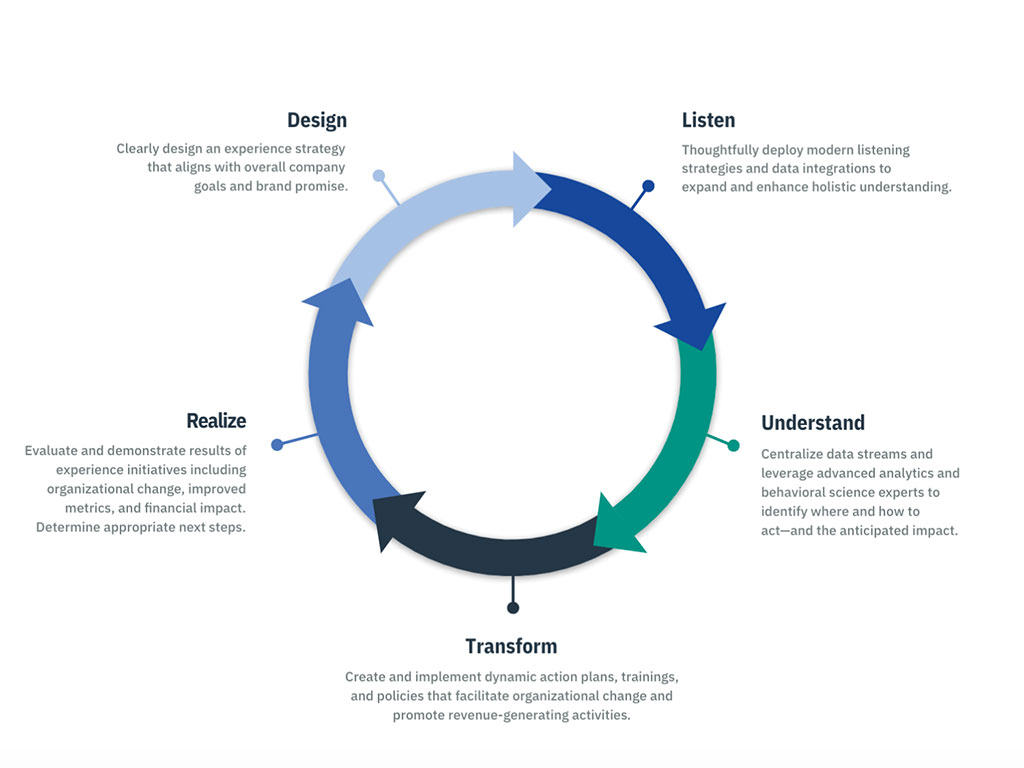
Every year, we at team InMoment like to look back and reflect on what we’ve learned about employee and customer Experience Improvement, and then put those top learnings into a “cheat sheet” of sorts for our readers. Building a customer experience program that helps you to differentiate from the competition is difficult—that’s where InMoment’s customer experience framework, the Continuous Improvement Framework comes in. This employee and customer experience framework will provide you with some of the best practices in the business to help you get the most out of your customer experience program.
So, sit back and read on to learn how our customer experience framework can benefit your business!
What Is a Customer Experience Framework?
As a starting point, it is important to define what a customer experience framework is.
A customer experience framework is a set of processes a company implements in conjunction with its customer experience program to help the program be as successful as possible in its efforts to improve the customer experience, create a customer-centric culture, and positively impact the bottom line. It is like an map that you follow as you go through all the steps of gathering feedback from customers and improving processes based on the feedback.
Without a customer experience framework, it is hard to get consistent results you want. But with a customer experience framework, you’ll be able to make your CX program consistently successful, and adapt your program to scale and evolve with your company, customers, and the greater market.
The Continuous Improvement Customer Experience Framework
Your Path to Employee & Customer Experience Improvement Success
The key to InMoment’s customer experience framework, the Continuous Improvement Framework, is to move beyond merely monitoring employee and customer feedback. Instead, experience professionals need to focus on using that feedback to inform action plans. Customer narratives are a goldmine for companies looking to eradicate superficial and deep-seated problems. Their feedback allows you to identify issues, define remedies that positively impact the bottom line, and ultimately create more meaningful experiences.
Brands can achieve all of this by sticking to a simple, five-step customer experience framework that we call the Continuous Improvement Framework: define, listen, understand, transform, realize.

Step #1: Design
When folks start up their employee and customer Experience Improvement programs, they’re often tempted to start listening right off the bat. However, it is absolutely essential that experience professionals design their programs before they launch listening posts.
Here are some notes from InMoment expert Andrew Park about the first step of the customer experience framework, design:
“Listening to customers is obviously an integral part of any well-built experience program, but it isn’t enough on its own, especially when brands don’t truly know what they’re listening for. Listening broadly can be helpful, but far more useful is the capability (and the willingness) to listen purposefully.
There are mountains of data out there, and the only way for companies to own the moments that matter (when business, customer, and employee needs intersect) and thus achieve transformational success is to figure out how to listen purposefully. That’s why it’s important for brands to design their experience program’s goals, objectives, and other factors before turning the listening posts on.”
Want to read more from Andrew? Click here to access “Why ‘Just’ Listening to Your Customers Isn’t Enough”
Step #2: Listen
Now that you know what you’re listening for, you can start setting up your listening posts. And whenever most of us think about employee and customer listening, we tend to also think about surveys. But what are the best practices and philosophies successful listening programs follow?
Here’s Andrew Park again:
“Traditional forms of listening usually involve long-winded surveys that focus on single points within brand channels. These surveys may also take a spray-and-pray approach, asking about everything the brand cares about—but that customers may not. Finally, brands may also spend too much time focusing solely on solicited customer feedback, which results in fragmented data. Fortunately, brands can be more versatile when it comes to collecting feedback.”
Want a succinct look at how to achieve meaningful survey listening? Get the four steps you need to follow in “How to Achieve Meaningful Listening Through Surveys”
Steps #3: Understand
You’ve collected data at strategic touchpoints using best practices. Now it’s time to leverage analytics to get to the actionable insights in your data. That’s when text analytics come into the picture.
Text analytics are vital to your brand’s ability to understand your customer and employee experiences. You can have listening posts across every channel and at every point in the customer journey, but if you don’t have the best-possible text analytics solution in place, your ability to derive actionable intelligence from that data is essentially moot. And your ability to create transformational change across the organization and drive business growth? That’d be a non-starter without effective text analytics. Without them, all you have is a score, not any context or information on what actually went well or needs improvement.
It’s obvious that text analytics are vital, but in an industry full of jargon, claims about accuracy, and a huge amount of conflicting data, how can you tell what solution attributes will be the best for your company?
Learn everything you need to know about text analytics in this eBook.
Step #4: Transform
In our experience, we’ve found that the hardest step for programs to conquer is going from insights to action—and therefore, to transformation. This is also arguably the most important step in the employee and customer experience framework.
Transformation is an important step of the process not just because brands can actively improve themselves, but also because it’s what your customers expect is happening. Customers wouldn’t provide feedback if they didn’t expect brands to do something about it, so bear this in mind when working toward providing the best experience for them.
So how do you go from insights to transformation? Learn the process in this article.
Step #5: Realize
This is what you’ve been building toward all along: realizing employee and customer Experience Improvement. But what does true success look like? How do you prove it to your business stakeholders?
Here are some thoughts from InMoment XI Strategist Jim Katzman:
“Realizing success occurs when you can evaluate how well your program is hitting goals and when you can quantify the results. Even if you don’t hit a homerun against all your goals, evaluating what you have achieved—and what you haven’t—still gives you a great idea of what exactly about your program might need tweaking.
There’s another, more profound way to evaluate your experience program’s impact on the business, and that’s through the lens of four economic pillars. The handy thing about our model is that it’s broad enough to be of use to any company regardless of size, brand, or industry while also giving experience practitioners a foundation from which to evaluate additional financial metrics.”
Want to learn about the four economic pillars and other ways to quantify program results? Read Jim’s full piece here.
A World of Possibilities
With the right mindset and a proven employee and customer experience framework for success in place, the possibilities for your employee or customer experience improvement initiative are truly endless this next year.
With that, we’d like to say happy holidays from our team to yours!


